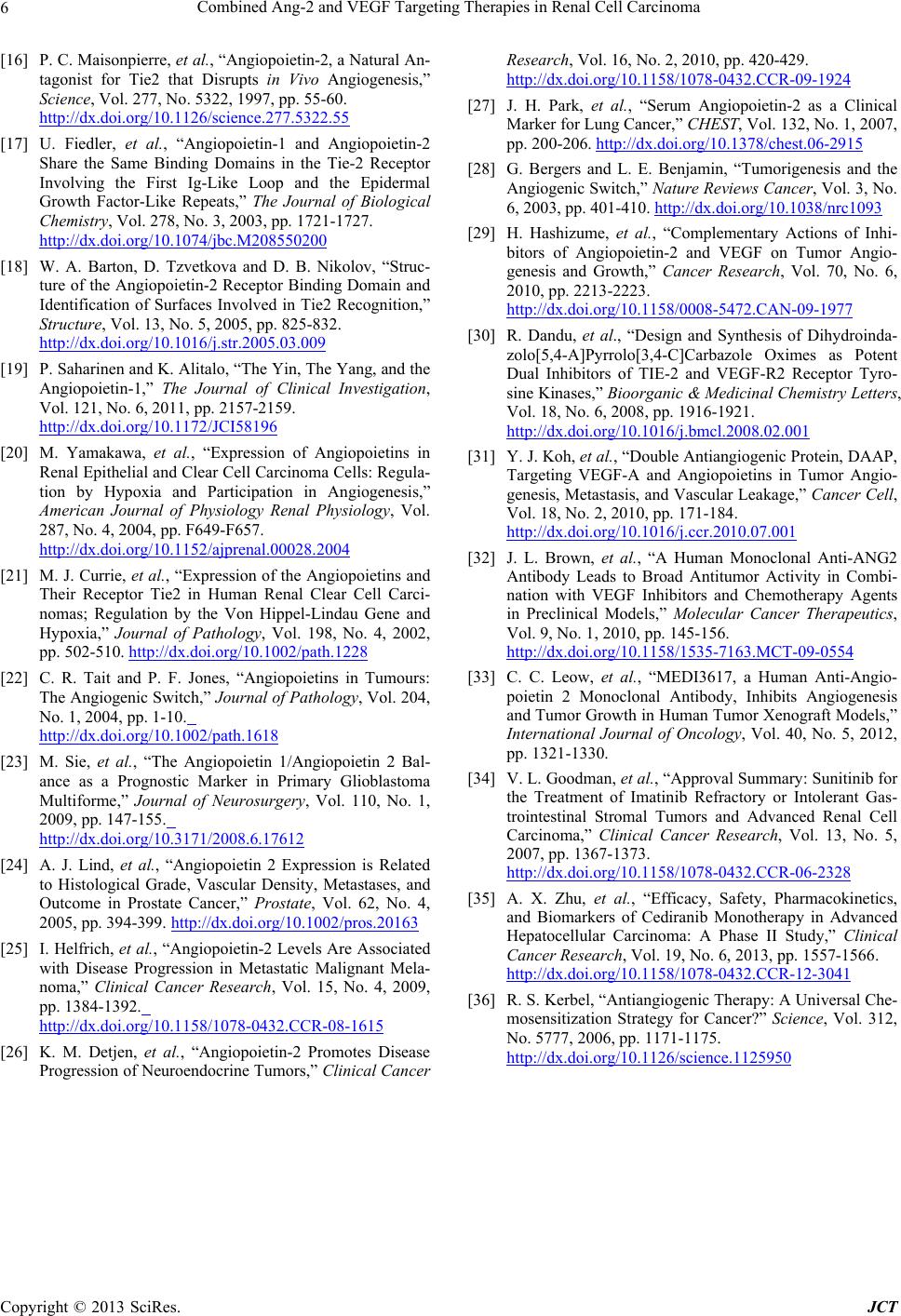
Combined Ang-2 and VEGF Targeting Therapies in Renal Cell Carcinoma
Copyright © 2013 SciRes. JCT
6
[16] P. C. Maisonpierre, et al., “Angiopoietin-2, a Natural An-
tagonist for Tie2 that Disrupts in Vivo Angiogenesis,”
Science, Vol. 277, No. 5322, 1997, pp. 55-60.
http://dx.doi.org/10.1126/science.277.5322.55
[17] U. Fiedler, et al., “Angiopoietin-1 and Angiopoietin-2
Share the Same Binding Domains in the Tie-2 Receptor
Involving the First Ig-Like Loop and the Epidermal
Growth Factor-Like Repeats,” The Journal of Biological
Chemistry, Vol. 278, No. 3, 2003, pp. 1721-1727.
http://dx.doi.org/10.1074/jbc.M208550200
[18] W. A. Barton, D. Tzvetkova and D. B. Nikolov, “Struc-
ture of the Angiopoietin-2 Receptor Binding Domain and
Identification of Surfaces Involved in Tie2 Recognition,”
Structure, Vol. 13, No. 5, 2005, pp. 825-832.
http://dx.doi.org/10.1016/j.str.2005.03.009
[19] P. Saharinen and K. Alitalo, “The Yin, The Yang, and the
Angiopoietin-1,” The Journal of Clinical Investigation,
Vol. 121, No. 6, 2011, pp. 2157-2159.
http://dx.doi.org/10.1172/JCI58196
[20] M. Yamakawa, et al., “Expression of Angiopoietins in
Renal Epithelial and Clear Cell Carcinoma Cells: Regula-
tion by Hypoxia and Participation in Angiogenesis,”
American Journal of Physiology Renal Physiology, Vol.
287, No. 4, 2004, pp. F649-F657.
http://dx.doi.org/10.1152/ajprenal.00028.2004
[21] M. J. Currie, et al., “Expression of the Angiopoietins and
Their Receptor Tie2 in Human Renal Clear Cell Carci-
nomas; Regulation by the Von Hippel-Lindau Gene and
Hypoxia,” Journal of Pathology, Vol. 198, No. 4, 2002,
pp. 502-510. http://dx.doi.org/10.1002/path.1228
[22] C. R. Tait and P. F. Jones, “Angiopoietins in Tumours:
The Angiogenic Switch,” Journal of Pathology, Vol. 204,
No. 1, 2004, pp. 1-10.
http://dx.doi.org/10.1002/path.1618
[23] M. Sie, et al., “The Angiopoietin 1/Angiopoietin 2 Bal-
ance as a Prognostic Marker in Primary Glioblastoma
Multiforme,” Journal of Neurosurgery, Vol. 110, No. 1,
2009, pp. 147-155.
http://dx.doi.org/10.3171/2008.6.17612
[24] A. J. Lind, et al., “Angiopoietin 2 Expression is Related
to Histological Grade, Vascular Density, Metastases, and
Outcome in Prostate Cancer,” Prostate, Vol. 62, No. 4,
2005, pp. 394-399. http://dx.doi.org/10.1002/pros.20163
[25] I. Helfrich, et al., “Angiopoietin-2 Levels Are Associated
with Disease Progression in Metastatic Malignant Mela-
noma,” Clinical Cancer Research, Vol. 15, No. 4, 2009,
pp. 1384-1392.
http://dx.doi.org/10.1158/1078-0432.CCR-08-1615
[26] K. M. Detjen, et al., “Angiopoietin-2 Promotes Disease
Progression of Neuroendocrine Tumors,” Clinical Cancer
Research, Vol. 16, No. 2, 2010, pp. 420-429.
http://dx.doi.org/10.1158/1078-0432.CCR-09-1924
[27] J. H. Park, et al., “Serum Angiopoietin-2 as a Clinical
Marker for Lung Cancer,” CHEST, Vol. 132, No. 1, 2007,
pp. 200-206. http://dx.doi.org/10.1378/chest.06-2915
[28] G. Bergers and L. E. Benjamin, “Tumorigenesis and the
Angiogenic Switch,” Nature Reviews Cancer, Vol. 3, No.
6, 2003, pp. 401-410. http://dx.doi.org/10.1038/nrc1093
[29] H. Hashizume, et al., “Complementary Actions of Inhi-
bitors of Angiopoietin-2 and VEGF on Tumor Angio-
genesis and Growth,” Cancer Research, Vol. 70, No. 6,
2010, pp. 2213-2223.
http://dx.doi.org/10.1158/0008-5472.CAN-09-1977
[30] R. Dandu, et al., “Design and Synthesis of Dihydroinda-
zolo[5,4-A]Pyrrolo[3,4-C]Carbazole Oximes as Potent
Dual Inhibitors of TIE-2 and VEGF-R2 Receptor Tyro-
sine Kinases,” Bioorganic & Medicinal Chemistry Letters,
Vol. 18, No. 6, 2008, pp. 1916-1921.
http://dx.doi.org/10.1016/j.bmcl.2008.02.001
[31] Y. J. Koh, et al., “Double Antiangiogenic Protein, DAAP,
Targeting VEGF-A and Angiopoietins in Tumor Angio-
genesis, Metastasis, and Vascular Leakage,” Cancer Cell,
Vol. 18, No. 2, 2010, pp. 171-184.
http://dx.doi.org/10.1016/j.ccr.2010.07.001
[32] J. L. Brown, et al., “A Human Monoclonal Anti-ANG2
Antibody Leads to Broad Antitumor Activity in Combi-
nation with VEGF Inhibitors and Chemotherapy Agents
in Preclinical Models,” Molecular Cancer Therapeutics,
Vol. 9, No. 1, 2010, pp. 145-156.
http://dx.doi.org/10.1158/1535-7163.MCT-09-0554
[33] C. C. Leow, et al., “MEDI3617, a Human Anti-Angio-
poietin 2 Monoclonal Antibody, Inhibits Angiogenesis
and Tumor Growth in Human Tumor Xenograft Models,”
International Journal of Oncology, Vol. 40, No. 5, 2012,
pp. 1321-1330.
[34] V. L. Goodman, et al., “Approval Summary: Sunitinib for
the Treatment of Imatinib Refractory or Intolerant Gas-
trointestinal Stromal Tumors and Advanced Renal Cell
Carcinoma,” Clinical Cancer Research, Vol. 13, No. 5,
2007, pp. 1367-1373.
http://dx.doi.org/10.1158/1078-0432.CCR-06-2328
[35] A. X. Zhu, et al., “Efficacy, Safety, Pharmacokinetics,
and Biomarkers of Cediranib Monotherapy in Advanced
Hepatocellular Carcinoma: A Phase II Study,” Clinical
Cancer Research, Vol. 19, No. 6, 2013, pp. 1557-1566.
http://dx.doi.org/10.1158/1078-0432.CCR-12-3041
[36] R. S. Kerbel, “Antiangiogenic Therapy: A Universal Che-
mosensitization Strategy for Cancer?” Science, Vol. 312,
No. 5777, 2006, pp. 1171-1175.
http://dx.doi.org/10.1126/science.1125950